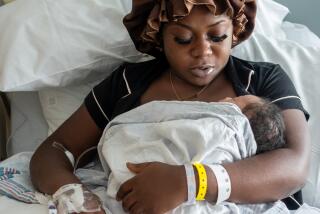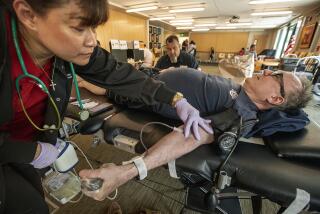More Pregnant Women Donating Own Blood : Fears of Diseases From Transfusions Increases Practice
- Share via
As she entered the final month of her pregnancy, Ilene Tindall was well aware of the horror stories about hospital patients contracting infectious diseases from tainted blood.
Like a growing number of pregnant women, Tindall decided that, in the event she or her newborn child needed blood during or after delivery, she would feel safest knowing that it came from an unquestionable source: herself.
After consulting with her obstetrician about the risks involved, Tindall readily joined the expanding ranks of pregnant women who, concerned over the quality of community blood banks’ supply, decide to store their own blood for possible use during delivery.
‘This Way I Have Peace’
“This blood will be 100% safe,” Tindall said shortly before technicians from the North County Blood Bank drew her blood at Pomerado Hospital this week. “This way, I have peace of mind about the quality of blood.”
Fearful of contracting diseases such as AIDS or hepatitis from donors at community blood banks, hundreds--and maybe thousands--of pregnant women are making the same decision as Tindall.
During 1987, member blood banks of the Arlington, Va.-based American Assn. of Blood Banks drew 282,856 units of self-donated blood from people facing a variety of medical procedures--more than double the 124,454 units of self-donated blood drawn the year before.
That dramatic increase in self-donated blood, blood bankers say, is attributable largely to increasing concerns that community blood supplies may be tainted by infectious diseases.
However, despite the rising interest in so-called “autologous” donations among pregnant women, the blood banking community has not yet developed firm guidelines on how--or even whether--some pregnant mothers should donate their own blood.
Because of caution among obstetricians and blood banks about changing past practices, autologous blood donations by pregnant women remain “relatively rare,” according to Dr. Rebecca Flack, assistant medical director of the San Diego Blood Bank, which stores blood donated by pregnant women.
Research Encouraging
“We do draw blood if they know they’re probably going to need it,” Flack said. “And no one would argue that the safest blood transfusion for both mother and fetus is blood that comes from Mom.”
Research conducted so far strongly suggests that it is safe for pregnant women to donate their own blood for future use, according to Tindall’s obstetrician, Vivian Ellis, who is on staff at the Scripps Clinic and Research Foundation.
Although Ellis describes such donations as being compatible with her “conservative approach to labor and delivery,” the issue of whether pregnant women should donate blood is actively debated within the medical community.
A recent blood bank association publication includes sections titled “Should Pregnant Patients Be Autologous Blood Donors?” and “Unanswered Questions Regarding Safety and Effectiveness” of self-donations by pregnant women.
“My concern is that it should not become a commonplace procedure,” said Merlin Sayers, medical director of the Puget Sound Blood Center in Seattle. “Under some (blood banks), it has become a routine procedure.
Some doctors worry that the risks faced by pregnant women who donate blood outweigh “the risks she’s trying to avoid,” Sayers said.
Special Problems
For example, pregnant women and fetuses might face special problems on the “very rare occasions” when donors faint or experience lowered blood pressure or a dramatically slowed pulse, Sayers explained.
“While those are very innocuous events for a healthy adult, we (cannot yet) . . . say those are innocuous for a woman who is a few weeks away from delivery, or for the fetus,” Sayers said.
Tindall, whose first child was born nearly two years ago through a Caesarean section, opted for an autologous donation because her second child is to be delivered by a vaginal birth. She made the decision after discussing the possibility with her husband and obstetrician Ellis.
Ellis advised Tindall to consider an autologous donation because complications can occur when a woman chooses a vaginal birth after a Caesarean section.
But, even though Ellis strongly supported the autologous donation--as she routinely does for mothers who face some risk during delivery--Tindall realized that such donations are not the norm.
“My sister (in Wisconsin) is an OB nurse in delivery, and she had never heard of” pregnant women donating blood to be used should a complication arise during delivery, Tindall said.
Drawn in Third Trimester
For obstetricians, “the first requirement is a healthy mom and baby,” Ellis said. The blood usually is drawn during the third trimester because it can be stored without freezing--and delivered immediately should a transfusion become necessary.
Pregnant women now account for about 40% of all autologous blood drawn by the Beth Israel Hospital’s blood bank in Boston, according to Linda Chambers, associate medical director of the bank, which has conducted research into autologous donations by pregnant women.
Interest is high among pregnant women “because they tend to be highly motivated and most are acutely aware of any risk to them and their family,” Chambers said.
Beth Israel’s blood bank has safely drawn enough blood from healthy, pregnant women to erase fears that the procedure is dangerous, Chambers said. Consequently, the Boston hospital no longer does in-depth monitoring while drawing the blood.
The San Diego Blood Bank conducts in-depth interviews with pregnant women to determine if they and their fetuses are healthy. Nurses with acute-care training draw the blood.
“When we have drawn blood, the people have done fine,” said Victor DePratti, medical director of the San Diego Blood Bank. “They don’t necessarily require monitoring.”
In contrast, the North County Blood Bank routinely subjects mothers and fetuses to extensive observation before, during and after the donation is drawn. During Tindall’s procedure, technicians used an electronic device to monitor her heartbeat while a second monitor tracked the fetal heartbeat. That monitoring added $25 to the blood bank’s typical $94 charge for self-donation.
To Sayers, the different monitoring practices underscore the need for caution.
“That simply emphasizes that we don’t have enough experience,” Sayers said. “If we had enough experience, I don’t think you’d see such widely divergent” monitoring procedures.
More to Read
Sign up for Essential California
The most important California stories and recommendations in your inbox every morning.
You may occasionally receive promotional content from the Los Angeles Times.













